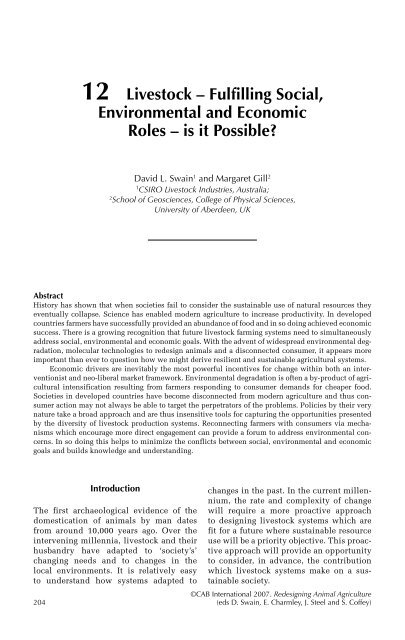Redesigning Animal Agriculture
Redesigning Animal Agriculture
Redesigning Animal Agriculture
You also want an ePaper? Increase the reach of your titles
YUMPU automatically turns print PDFs into web optimized ePapers that Google loves.
12 Livestock – Fulfilling Social,<br />
Environmental and Economic<br />
Roles – is it Possible?<br />
David L. Swain 1 and Margaret Gill 2<br />
1 CSIRO Livestock Industries, Australia;<br />
2 School of Geosciences, College of Physical Sciences,<br />
University of Aberdeen, UK<br />
Abstract<br />
History has shown that when societies fail to consider the sustainable use of natural resources they<br />
eventually collapse. Science has enabled modern agriculture to increase productivity. In developed<br />
countries farmers have successfully provided an abundance of food and in so doing achieved economic<br />
success. There is a growing recognition that future livestock farming systems need to simultaneously<br />
address social, environmental and economic goals. With the advent of widespread environmental degradation,<br />
molecular technologies to redesign animals and a disconnected consumer, it appears more<br />
important than ever to question how we might derive resilient and sustainable agricultural systems.<br />
Economic drivers are inevitably the most powerful incentives for change within both an interventionist<br />
and neo-liberal market framework. Environmental degradation is often a by-product of agricultural<br />
intensification resulting from farmers responding to consumer demands for cheaper food.<br />
Societies in developed countries have become disconnected from modern agriculture and thus consumer<br />
action may not always be able to target the perpetrators of the problems. Policies by their very<br />
nature take a broad approach and are thus insensitive tools for capturing the opportunities presented<br />
by the diversity of livestock production systems. Reconnecting farmers with consumers via mechanisms<br />
which encourage more direct engagement can provide a forum to address environmental concerns.<br />
In so doing this helps to minimize the conflicts between social, environmental and economic<br />
goals and builds knowledge and understanding.<br />
Introduction<br />
The first archaeological evidence of the<br />
domestication of animals by man dates<br />
from around 10,000 years ago. Over the<br />
intervening millennia, livestock and their<br />
husbandry have adapted to ‘society’s’<br />
changing needs and to changes in the<br />
local environments. It is relatively easy<br />
to understand how systems adapted to<br />
changes in the past. In the current millennium,<br />
the rate and complexity of change<br />
will require a more proactive approach<br />
to designing livestock systems which are<br />
fit for a future where sustainable resource<br />
use will be a priority objective. This proactive<br />
approach will provide an opportunity<br />
to consider, in advance, the contribution<br />
which livestock systems make on a sustainable<br />
society.<br />
©CAB International 2007. <strong>Redesigning</strong> <strong>Animal</strong> <strong>Agriculture</strong><br />
204 (eds D. Swain, E. Charmley, J. Steel and S. Coffey)










